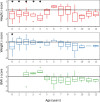Congenital central hypoventilation syndrome in korea: 20 years of clinical observation and evaluation of the ventilation strategy in a single center
- PMID: 38780650
- PMCID: PMC11263406
- DOI: 10.1007/s00431-024-05611-6
Congenital central hypoventilation syndrome in korea: 20 years of clinical observation and evaluation of the ventilation strategy in a single center
Erratum in
-
Correction to: Congenital central hypoventilation syndrome in korea: 20 years of clinical observation and evaluation of the ventilation strategy in a single center.Eur J Pediatr. 2024 Nov 9;184(1):2. doi: 10.1007/s00431-024-05869-w. Eur J Pediatr. 2024. PMID: 39520584 Free PMC article. No abstract available.
Abstract
Congenital central hypoventilation syndrome (CCHS) is a rare genetic disorder characterized by hypoventilation due to impaired breathing control by the central nervous system and other symptoms of autonomic dysfunction. Mutations in paired-like homeobox 2 B (PHOX2B) are responsible for most cases of CCHS. Patients with CCHS have various phenotypes and severities, making the diagnosis difficult. This study aimed to present a comprehensive single-center experience of patients with CCHS, including key clinical features, treatment strategies, and outcomes. A retrospective chart review was performed for patients diagnosed with CCHS between January 2001 and July 2023 at Seoul National University Children's Hospital. Finally, we selected 24 patients and collected their demographic data, genotypes, ventilation methods, and clinical features related to autonomic dysfunction. The relationship between the clinical manifestations and genotypes was also examined. All patients used home ventilators, and tracheostomy was performed in 87.5% of patients. Fifteen (62.5%) patients had constipation and nine (37.5%) were diagnosed with Hirschsprung disease. Arrhythmia, endocrine dysfunction, and subclinical hypothyroidism were present in nine (37.5%), six patients (25.0%), and two patients (16.7%), respectively. A significant number of patients exhibited neurodevelopmental delays (19 patients, 79.2%). There was a correlation between the phenotype and genotype of PHOX2B in patients with CCHS. (r = 0.71, p < 0.001). Conclusion: There was a positive correlation between paired-like homeobox 2 B mutations (especially the number of GCN repeats in the polyalanine repeat mutations sequence) and clinical manifestations. This study also demonstrated how initial treatment for hypoventilation affects neurodevelopmental outcomes in patients with CCHS. What is Known: • Congenital central hypoventilation syndrome is a rare genetic disorder characterized by hypoventilation and dysfunction of autonomic nervous system. • The disease-defining gene of CCHS is PHOX2B gene - most of the cases have heterozygous PARMs and the number of GCN triplets varies among the patients(20/24 - 20/33). What is New: • We have noted in the Korean patients with CCHS that there is a correlation between genotype (number of GCN repeats) and severity of phenotype. • National support for rare diseases allowed for a prompter diagnosis of patients with CCHS in Korean population.
Keywords: Autonomic dysfunction; CCHS; Neurodevelopmental delay; PHOX2B.
© 2024. The Author(s).
Conflict of interest statement
The authors declare no competing interests.
Figures




References
-
- Trang H, Girard A, Laude D, Elghozi JL (2005) Short-term blood pressure and heart rate variability in congenital central hypoventilation syndrome (Ondine’s curse). Clin Sci (Lond) 108(3):225–230. 10.1042/CS20040282 - PubMed
-
- Shimokaze T, Sasaki A, Meguro T, Hasegawa H, Hiraku Y, Yoshikawa T et al (2015) Genotype-phenotype relationship in Japanese patients with congenital central hypoventilation syndrome. J Hum Genet 60(9):473–477. 10.1038/jhg.2015.65. Epub 2015 Jun 11 - PubMed
-
- Korea Disease Control and Prevention Agency (KDCA). Annual report on the rare disease patients in Korea 2019–2021. https://helpline.kdca.go.kr/cdchelp/ph/ptlcontents/selectPtlConSent.do?s.... Accessed 30 Nov 2023. In Korean
-
- Bachetti T, Ceccherini I (2020) Causative and common PHOX2B variants define a broad phenotypic spectrum. Clin Genet 97(1):103–113. 10.1111/cge.13633. Epub 2019 Aug 30 - PubMed
MeSH terms
Substances
Supplementary concepts
Grants and funding
LinkOut - more resources
Full Text Sources
Research Materials

